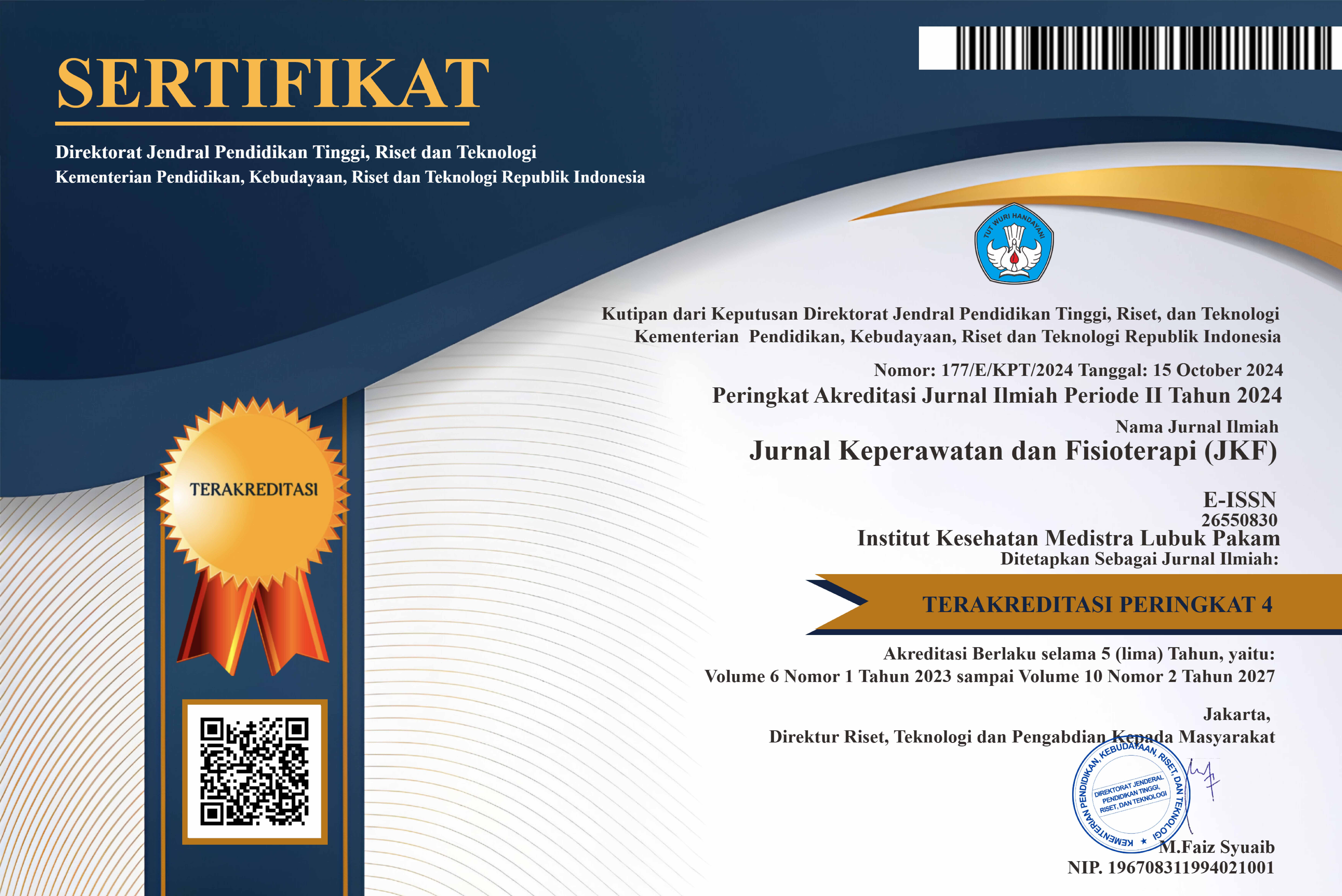Differences In Knee Valgus Degrees In Cutting And Drop Landing On The Dominant And Non-Leg Dominant In High School Basketball Players
DOI:
https://doi.org/10.35451/jkf.v6i1.1700Keywords:
cutting, drop landing, risk of knee injury, dominan, non-dominanAbstract
Background: Basic techniques, physical endurance, and teamwork in basketball are components needed to improve individual quality to be able to play with good performance. Basic techniques and movements often occur quickly and suddenly, including cutting and drop landing. Both of these movements are prone to knee injury. The majority of lower extremity injuries in basketball players are anterior cruciate ligament (ACL) strains. Observation of the knee valgus angle is required to assess the risk of knee injury. One of the risks has the potential to cause a knee injury is the dominant and non-dominant knee. This is because the leg have an important role in controlling posture and stability. Purpose: this study was to determine the differences in the risk factors for the dominant and non-dominant leg in cutting and drop landing. Methods: The research was analytic observational, a cross-sectional study design. The population in this study were high school basketball players in Malang City with a total sample of 22 people the inclusion and exclusion criteria (n=22). Data collection was carried outthe Waterloo Footedness Questionnaire-Revised (WFQ-R) and Frontal Plane Projection Angle (FPPA) as measuring tools using the kinovea software. Results: Based on the analysis Wilcoxon test forcutting and drop landing movements, a value of 0.036 (p <0.05) was obtained for the non-dominant leg, which means that there is a significant difference between the two movements. Conclusion: It canbe concluded that there are differences movements of cutting and drop landing on the non-dominant leg compared to the dominant leg.
Downloads
References
BHISE, S., & PATIL, N. (2016). Dominant and Non-dominant Leg Activities in Young Adults. International Journal of Therapies and Rehabilitation Research, 5(4), 257. https://doi.org/10.5455/ijtrr.000000172
Brighenti, A., Noé, F., Stella, F., Schena, F., & Mourot, L. (2022). Warm-Up Improves Balance Control Differently in the Dominant and Non-Dominant Leg in Young Sportsmen According to Their Experience in Asymmetric or Symmetric Sports. International Journal of Environmental Research and Public Health, 19(8). https://doi.org/10.3390/ijerph19084562
Butler, L. S., Milian, E. K., Deverna, A., Latz, K., Ellis, H. B., Martinez, A. R., Hayden, K., Gerstenkorn, C., Carpenito, S. C., Wyatt, C. W., & Sugimoto, D. (2021a). Reliability of the cutting alignment scoring tool (CAST) to assess trunk and limb alignment during a 45-degree side-step cut. International Journal of Sports Physical Therapy, 16(2), 312–321. https://doi.org/10.26603/001c.21419
Dos’Santos, T., Bishop, C., Thomas, C., Comfort, P., & Jones, P. A. (2019). The effect of limb dominance on change of direction biomechanics: A systematic review of its importance for injury risk. In Physical Therapy in Sport (Vol. 37, pp. 179–189). Churchill Livingstone. https://doi.org/10.1016/j.ptsp.2019.04.005
Guo, L., Zhang, J., Wu, Y., & Li, L. (2021). Prediction of the Risk Factors of Knee Injury During Drop-Jump Landing With Core-related Measurements in Amature Basketball Players. Frontiers in Bioengineering and Biotechnology, 9. https://doi.org/10.3389/fbioe.2021.738311
Irawan, D. S., Huoth, C., Sinsurin, K., Kiratisin, P., Vachalathiti, R., & Richards, J. (2022). Concurrent Validity and Reliability of Two-dimensional Frontal Plane Knee Measurements during Multi-directional Cutting Maneuvers. International Journal of Sports Physical Therapy, 17(2). https://doi.org/10.26603/001c.31651https://doi.org/10.3390/ijerph17124418
Mizuno, F., Koganemaru, S., Irisawa, H., Saito, A., & Mizushima, T. (2021). Knee Valgus during Jump Landing Is Related to the Inaccuracy of Knee Position Recognition in Healthy Young Women. Progress in Rehabilitation Medicine, 6(0), n/a. https://doi.org/10.2490/prm.20210041
Nugroho, R. A., & Yuliandra, R. (2021). ANALISIS KEMAMPUAN POWER OTOT TUNGKAI PADA ATLET BOLABASKET. Sport Science & Education Journal, 2(1). https://ejurnal.teknokrat.ac.id/index.php/sport/issue/archive
Promsri, A., Haid, T., Werner, I., & Federolf, P. (2020). Leg dominance effects on postural control when performing challenging balance exercises. Brain Sciences, 10(3). https://doi.org/10.3390/brainsci10030128
Robles-Palazón, F. J., Ruiz-Pérez, I., Oliver, J. L., Ayala, F., & Sainz de Baranda, P. (2021). Reliability, validity, and maturation-related differences of frontal and sagittal plane landing kinematic measures during drop jump and tuck jump screening tests in male youth soccer players. Physical Therapy in Sport, 50, 206–216. https://doi.org/10.1016/j.ptsp.2021.05.009
Sankey, S. P., Robinson, M. A., & Vanrenterghem, J. (2020). Whole-body dynamic stability in side cutting: Implications for markers of lower limb injury risk and change of direction performance. Journal of Biomechanics, 104. https://doi.org/10.1016/j.jbiomech.2020.109711
Schmitz, R. J., Cone, J. C., Tritsch, A. J., Pye, M. L., Montgomery, M. M., Henson, R. A., & Shultz, S. J. (2014). Changes in Drop-Jump Landing Biomechanics During Prolonged Intermittent Exercise. Sports Health, 6(2), 128–135. https://doi.org/10.1177/1941738113503286
Teng, P. S. P., Leong, K. F., & Kong, P. W. (2020). Influence of Foot-Landing Positions at Initial Contact on Knee Flexion Angles for Single-Leg Drop Landings. Research Quarterly for Exercise and Sport, 91(2),316–325. https://doi.org/10.1080/0270136
Downloads
Published
Issue
Section
License
Copyright (c) 2023 Dhea Salsa Bila

This work is licensed under a Creative Commons Attribution 4.0 International License.
Copyright in each article is the property of the Author.


























